► Electric crossover SUVs tested
► Ford, VW, Hyundai and Volvo battle it out
► Will they replace conventional family cars?
All of a sudden EVs are normal. Hyundai’s been at it for a couple of years now but Ford, VW and Volvo are bringing electric crossovers to the mainstream. Are any of these four EVs good enough to replace the nation’s favourite cars?
Pre-flight briefing: Ford Mustang Mach-E
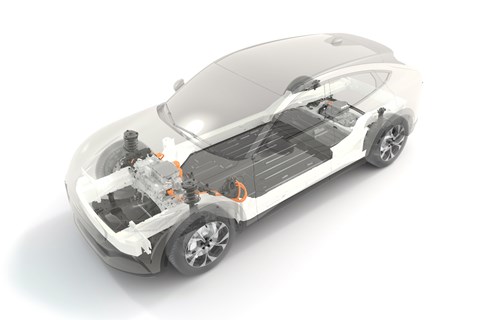
Why is it here?
Because it’s a Ford, and when Ford does something that means it’s gone mainstream. And because it’s a Mustang, or at least that’s what the badges claim. We want to know if there’s more to it than marketing, and whether it has the dynamic advantage we expect from Ford.
Any clever stuff?
There’s a keypad on the door so you can open it you’ve forgotten your key, or if you’re using your phone as a key and the phone’s battery has died. And there are no exterior door handles: push the button and the door pops open – unless somehow the car battery’s flat…
Which version is this?
The entry-level £40,350 rear-wheel-drive Mach-E with the standard 75.7kWh battery. A bi-motor, four-wheel-drive version starts at £46,650, and you can size-up the battery in either car to 99kWh. Going for the big pack and AWD slices 1.1sec off the base car’s 6.9sec 0-62mph time.
Read our Ford Mustang Mach-E review
Pre-flight briefing: VW ID.4
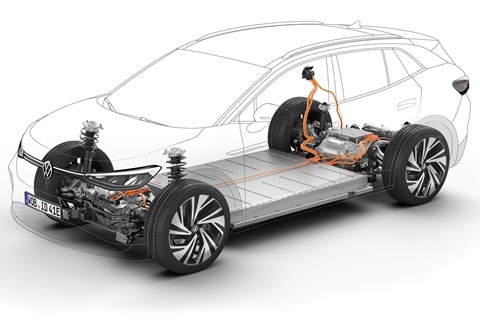
Why is it here?
Big brother to the ID.3 hatch, the Tiguan-sized ID.4 is VW’s first electric SUV. It’s built on the same versatile MEB electric car platform as the ID.3 and upcoming Cupra el-Born and Audi Q4 e-Tron. Since VW isn’t building an electric Tiguan, if you want an e-VW SUV, this is it.
Any clever stuff?
The ID’s exterior door handles look like they’d pull outwards, though in fact are fitted with touch-sensitive micro-switches. They feel strange to use, but more worryingly the handle insert seems insufficiently anchored to the door structure – just one example of less than stellar build quality on a car that deserves better.
Which version is this?
The 1st Edition is the only ID.4 currently available. It has a 77kWh battery, a single motor driving the rear wheels, and is claimed to do 310 miles. Many more ID.4s are on the way.
Read our VW ID.4 review
Pre-flight briefing: Volvo XC40 Recharge
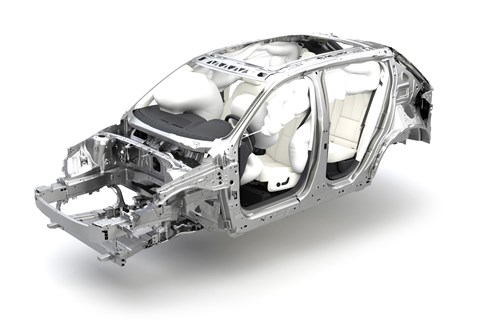
Why is it here?
It’s Volvo’s first electric car. It’s also an XC40, which means it looks great inside and out and has a decent boot. Plus, this one’s a proper Q-car: 0-62mph takes just 4.9sec.
Any clever stuff?
Volvo’s latest infotainment system is Android-based and developed with Google. You can sign in with your Google account to personalise apps such as Spotify, and control most functions with voice commands using Google Assistant – which, unlike most voice-recognition systems – understands your request and replies quickly.
Which version is this?
At the time of writing this £53k version is the only all-electric XC40 available. But a lower-spec car comes soon, followed by a smaller battery option. And it’ll be joined by a single-motor front-wheel-drive version that will be significantly more affordable.
Read our Volvo XC40 Recharge review
Pre-flight briefing: Hyundai Kona Electric
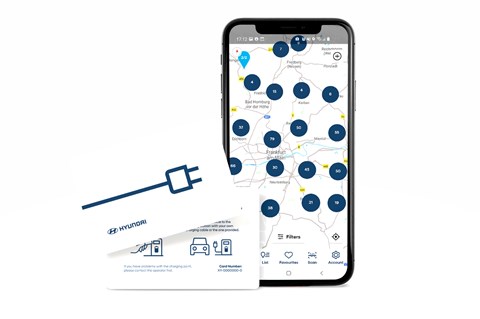
Why is it here?
The original Kona Electric struck such a chord with a public there was a 12-month wait for delivery. That frenzy has subsided but the Kona still looks strong value and a recent facelift brings a new nose and extra driving range: up from 279 to 300 miles in the 64kWh version.
Any clever stuff?
How about something not very clever? There’s no front boot, or frunk, in the Kona, which is a bummer because it only has 332 litres at the back. Strangely, given it’s a dedicated EV design, the ID.4 doesn’t have one either, but then it’s got a massive 543-litre rear boot.
Which version is this?
Kona prices start at £30,625 for the SE Connect with the base 39kWh battery. A mid-spec Premium version is the car in this test, but we also jumped into a Kona with the 64kWh battery option (see p109) to see if the £5k premium for the extra capacity is worth the wedge.
Read our Hyundai Kona Electric review
Ohm working: ID.4 vs Mach-E vs XC40 vs Kona
If you feel like you’re struggling to keep up with the electric revolution taking place in the car market, you’re not alone. Even when you think you’ve finally got your head round the charging times and charging types, something seismic can happen that moves the goalposts into the next stadium.
Case in point: between us driving the cars in this test and sitting down to tell you about it, the British government completely upended the entire sector by reducing the £3000 electric car grant to £2500, and slashing the price cap on eligible cars from £50,000 to £35,000. When we took these photographs, three of the cars qualified for a subsidy. As it stands now, only one does, giving a surprise advantage to the cheapest car in the test, while the car that looked conspicuously expensive before is suddenly back in the running.
The car back in the game is the Volvo XC40 Recharge P8. It’s Volvo’s first electric car, though it shares its guts with sister company Polestar’s 2 saloon. It was looking conspicuously expensive because Volvo chose to launch it, as is the current fashion, in full-on Carlos Fandango spec with loads of interior kit, two motors, four-wheel drive, and enough performance to see off all but the hottest of hot hatches from the lights.
More affordable, less extreme versions are on the way, but it’ll be a year until we’re able to buy the single-motor version that’ll probably be enough for most needs, and far more attainable than the sole £53,155 Recharge First Edition model you can buy right now.
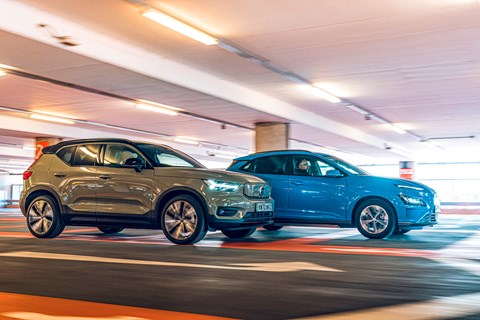
Costing £31,975 after the government grant, and now the only car in the test still eligible for it, is the recently facelifted Hyundai Kona. In fact, the cheapest Kona Electric is even cheaper than that. An entry-level Kona SE starts at £30,625, but we pushed the boat out for the mid-spec Premium, knowing that it would still look like a value proposition. The caveat is that we’re stuck with the smaller of the Kona’s two battery options. Upgrade to the bigger one and you’ll pay more, and more again because you bust the £35k grant cap.
As do the other two cars here. The ID.4 is the second of Volkswagen’s ID electric car family, big brother to the ID.3, and the company’s first e-SUV. It rides on a stretched version of the ID.3’s MEB platform and, like the Volvo, arrives only in a fancy launch spec. But the ID.4 1st Edition is still substantially cheaper than the Volvo, at £40,110 (it was effectively £37k until it lost the government’s patronage).
That puts the ID.4 head-to-head with the £40,350 Ford Mustang Mach-E, a car so contentious it finally gives the awful gas-crisis-era Mustang II from 1974 a break from the endless criticism of it being the least Mustang-like Mustang ever. Who cares if it’s not a ‘real’ Mustang, anyway? Probably not many in Britain, whose only connection to the badge is derived from a rose-tinted Hollywood-curated alternate reality that conveniently obscures the fact that most of the old ones were pretty rubbish. So take the Mustang for what it is, not what it says it is: a fun, fairly affordable electric family car with a familiar name.
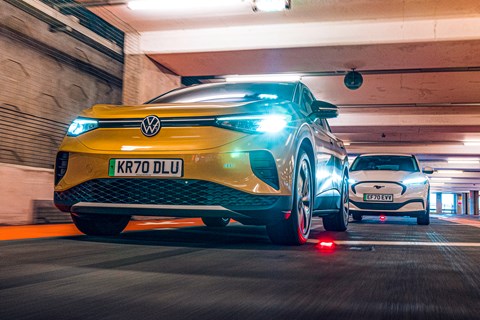
There are plenty of ‘proper’ Mustang styling cues, of course. You get the segmented tail lights, the menacingly slim headlights, a bonnet with simulated twin bulges mimicking the presence of a V8 underneath, and a galloping pony emblem on a grille that’s blocked off save for an upper outline that makes it look like the handle cut-out on a document crate. It doesn’t hit you over the head with the retro shtick. Strip away the details and it’s not that different from a conventional Ford SUV such as the Kuga. Until, that is, you open the door by pushing the weird eyeball on the B-pillar to pop it ajar, then tug it wide by pulling on a strange wing tab that looks like the cigarette holder above a ’70s public urinal.
Do that and the first thing you see is a vast touchscreen. The inside of the Mach-E is unlike the interior of any Mustang, or any Ford for that matter. Instead of conventional gauges, you get a letterbox-shaped digital instrument panel, and where most Fords combine a traditional bank of console buttons augmented by a touchscreen perched on top of the dash, in the Mach-E’s case it’s all screen. It certainly delivers the wow factor, and unlike older versions of Ford’s Sync infotainment system it’s fast and looks good. But it’s positioned oddly, feeling too vertical and not directed sufficiently towards the driver, as if the most important likely user was a toddler wedged into the storage cubby between the seats. Given that almost every function is operated through the screen, fitting it to the dash with some kind of universal joint allowing it to be tilted towards the driver’s seat for the many times you’re riding solo would be handy.

But you do get three major concessions to old-fashioned reach-out-and-grab-it practicality in the Mach-E. The starter button, the rotary volume control and the old Jag-style rotary gear selector are useful physical tools to make sure Ford buyers don’t feel like they’ve fallen asleep watching the snooker and woken up in 2075. And if the rear seat space and 402-litre boot (plus an 81-litre cubby in the nose) aren’t quite Mondeo-big, they’re usefully more in each case than a Ford Focus can offer, meaning most families will find it plenty big enough.
If it’s familiarity you want, the XC40 and Kona are the cars for you. Unlike the ID.4 and Mustang, which were designed from the ground up as electric cars, the Recharge and Kona Electric are simply electric versions of cars otherwise available with conventional petrol or hybrid powertrains.
In fact, it takes a fairly keen eye to spot that either is an EV at all, until you see the blanked grille on the nose, which is now smoother and even more distinctive on post-facelift Kona EVs. But not everyone wants to drive a motorised billboard for EV ownership, and besides, the XC40 is unarguably a fantastic bit of industrial design whatever’s under the bonnet.
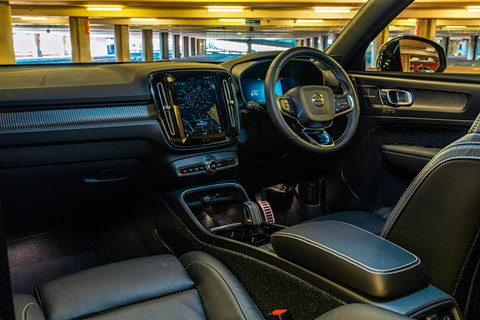
It’s the same story inside, where the Volvo looks little different to any other XC40. The cabin quality is solid, there’s more room than the fairly compact footprint suggests, and the dashboard makes up for its slighty dated, recessed touchscreen by fitting it with Google-developed software that means the voice-activated assistant has a hope of understanding your commands.
Hyundai’s mild tweaks to the Kona’s cabin include a 10.25-inch digital instrument display, but they can’t stop the cabin looking a little downmarket. There’s too much shiny grey plastic, and too many useful hard buttons to win over anybody seduced by the less practical, but more visually impressive, touchscreen of the Mustang.
The Kona’s big central tunnel – the sort of thing you get in front-engined GT cars – suddenly seems quaintly old-fashioned beside bespoke electric cars that celebrate their ability to provide an entirely flat floor. It also magnifies the snug feeling of the Kona’s fairly small cabin.
Very definitely wearing its electric heart on its sleeve is the ID.4, which is sleek, slightly androgynous, and not very well put together in places. While opinion among the CAR team evenly split on the merits of the ID.4’s exterior styling, we were mostly in agreement that it feels far less premium than it looks. From the way the battery charging flap opens and closes to the design and fit of the exterior door handles, from the hard feel of the door panel plastics to the sound of the electric windows, it feels slightly disappointing.
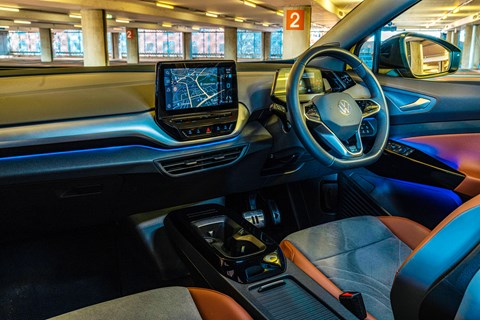
And if you’ve been to the Ford dealer first, you’ll also be disappointed by the size of the VW’s touchscreen. It’s a bit of stretch, and when your hand eventually gets there it discovers that the touch-sensitive slider controls for the climate control are as unpleasant to use as the buttons on the steering wheel, whose haptic feedback appears to be modelled on the world’s weediest electric fence. At least our car doesn’t have the hospital-white steering wheel.
If it sounds like we’re giving the ID.4 a good kicking, allow us to offer it a hand up from the floor by saying that in other respects this is a great interior. It’s clean, uncluttered and hugely relaxing because it abandons the usual SUV pretence at sportiness, favouring a low scuttle and deep windscreen, presenting an incredible view of the road ahead and giving the cabin a real sense of space.
That sense is not entirely a stylist’s trick. This is a roomy car, the roomiest here, with plenty of space spread across the two rows for four to sit comfortably on long journeys, while the flat floor means life wouldn’t be intolerable for a fifth, either. The ID.4 also has the biggest boot, a 543-litre loadbay, plus a little cubby below the floor that will be needed for storing your charging cable. You can’t put it in the front boot because the ID.4 doesn’t have one. While future ID.4s will get a second motor mounted up front, lift this one’s bonnet and all you’ll find is some heating gubbins and the electric power steering hardware. The motor is at the back, driving the rear wheels.
Along with the faster, four-wheel-drive variants, Volkswagen is also gearing up to launch less powerful ID.4s that come with a smaller battery and resulting smaller price – something that’s probably a whole lot more pressing since the grant changes.
But we’re not sure we’d want an ID.4 much slower than this one. If at first glance the single motor’s 201bhp doesn’t seem so terrible, you’re probably still thinking in petrol mode. Like all electric cars the ID.4 is heavier than a same-sized petrol machine; in this case it’s a pretty colossal 2124kg. It’s not that it feels slow exactly. Zero to 62mph takes 8.5sec, and the modest 229lb ft of torque is enough for most normal driving, while the excellent throttle mapping means the right pedal isn’t over-sharp, as on some electric cars. But there’s no evidence of the EV pep you’re probably expecting, and if you regularly drive with a full complement of people and their stuff you’ll want more go.
The XC40 certainly delivers on the go front. Packing a monstrous 402bhp and even crazier 487lb ft from its two motors, plus four-wheel drive to get the lot of it to the road, the Volvo erupts from a standing start, reaching 62mph in 4.9sec. Okay, so the same money buys a Tesla Model 3 that’s much faster, but this is still more performance than anyone will need from a car like this, particularly since it’s not actually that much fun to punt about.
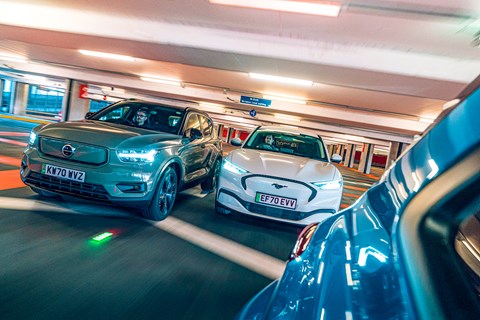
Yes, it’s unflappably secure, corners flatly and can be made to go very quickly down any kind of road, but you never feel connected to the XC40 through the numb steering or inclined to really wind it up and unleash all of that power. And when you do, you’ll be wishing for some chunkier seat bolsters. The seats are like Victorian parents: supportive in principle, but never there with a hug when you really need one.
What really does grab you, though, is the Volvo’s selectable one-pedal function, which applies so much regenerative braking effect you’ll feel like you’ve left the handbrake on when you try to manoeuvre out of your parking spot. Some will love it, and find it preferable to the ID.4’s set-up, which – even with its ‘B’ for ‘braking’ mode selected – offers very little, because VW thinks coasting is more efficient. But it seems a little overdone.
Hyundai, meanwhile, offers multiple regenerative settings on the Kona, accessible by paddles behind the steering wheel, meaning it’s not hard to find a character you like. Getting to 62mph requires closer to 10sec, though the hefty 291lb ft of torque means it doesn’t feel much less potent than the supposedly quicker ID.4 in most situations, and should be ample if you stick to urban areas. The smaller battery also reduces driving range from 300 miles to less than 200.
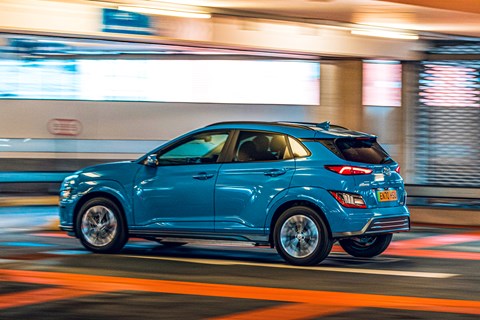
When it comes to the Mustang, however, we’d argue that you don’t need more than our standard-range, rear-wheel-drive car. Yes, the 5.8sec to 62mph and 335-mile range of the dual-motor, all-wheel-drive version with the bigger 99kWh battery sounds tempting, but we imagine most buyers will be happy to make do with 6.9sec.
We certainly were. The Mustang feels energetic and up for it in a way the ID.4 never is. True, the Volkswagen rides better, and its impeccable mechanical refinement amplified our disappointment in the Mustang’s pull-away shunt. But the Mustang makes the effort to involve you in the process of driving in the way the other cars here never do. Leave the anodyne Whisper mode with its mushy throttle and steering map alone, and stick to Active or the cringy Untamed, and the Mustang feels pleasantly alert, responding to inputs with an immediacy better matched to the kind of taut body control we’ve grown to expect after almost 30 years of dynamically excellent front-wheel-drive Fords.
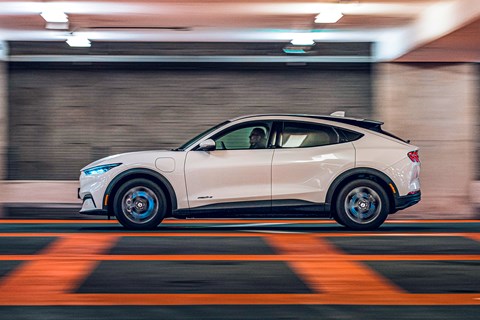
Except, of course, the Mach-E isn’t front-wheel drive. Give the right pedal a tickle on the exit of a roundabout and you can easily coax it into a cheeky oversteer slide the ID.4 wouldn’t dream of letting you get away with. You know, maybe the Mustang connection isn’t all marketing make-believe. And if the prospect of the base ‘Stang’s 273-mile range is giving you anxiety, pairing the bigger battery with the rear-drive hardware results in a low-stress 379 miles between digital fills, which you can do for free for five years using the Ionity network. In all these cars, our tests showed that your driving style and choice of route will have a measurable effect on the range.
The ID.4’s no-choice 77kWh battery gives it a 310-mile WLTP range, compared with 249 for the Volvo and 190 for the Kona, though our testing suggests a real range of around 75 per cent of each of those figures, which doesn’t look good for the Volvo. The XC counters by offering 150kW charging capability, compared to 125kW for the ID.4 and 115kW for the Mach-E, though in practice you’ll be stood in the Moto Services car park for around 35 minutes to fill each of them, except the Hyundai, whose 50kW max charging rate means a 50-minute wait.
Mach-E vs ID.4 vs XC40 vs Kona: final reckoning

You know you want an electric car, but that’s no longer enough. It might have been enough a decade ago when it was the Nissan Leaf or nothing, but these days there’s enough choice that you need to know what you want from your electric car besides it simply being electric.
If you need it to qualify for the UK government’s revised electric car grant and to look and feel like an eerily quiet version of a regular small SUV, then the Kona is your car. The base model is appealingly affordable, but its size and range mean it leans towards a second-car choice for many. Step up to the 64kWh battery to snare that impressive 300-mile range and the useful extra helping of performance – the two qualities you might want if you plan to make it your only wheels – and suddenly the cost advantage is mostly gone. And you’re left with a crossover SUV that’s not much bigger than a roomy supermini, nothing special to drive, and feels quite old inside despite the extra tech brought in with the facelift.
But the Kona was always the odd man out here. We threw it into the mix with much bigger, more expensive cars to see what happened if you cut your budget, much as we tossed in the Volvo to see the result of ballooning it. We love the XC40, and our initial impressions after driving this one on the launch were that we’d love it even more if it weren’t so expensive.
The grant changes have helped close the gap, and Volvo’s impressive no-deposit subscription deal – from £619 a month for three years if you’re happy with a low annual mileage limit – sounds a lot less terrifying than the £53k list price does, and includes servicing.
We can see why you’d be swayed by the Volvo’s extra performance and premium feel, but let’s assume that £80 is a deal breaker. Which of the remaining pair gets the nod? It’s a toughie.
The ID.4 should beat the Mustang to win, and for many, it will, at a canter. It’s more comfortable, more refined, more spacious. And let’s face it, some people will find the whole Mustang persona a bit trashy. The ID.4 feels like a glimpse into the future, but it’s one where driving cars gives little pleasure beyond the sense of freedom they instil.
The Mach-E might be a little rough round the edges, but it’s good to drive, full of personality, and fun to be around, real Mustang or not.
Mach-E vs ID.4 vs XC40 vs Kona: verdict
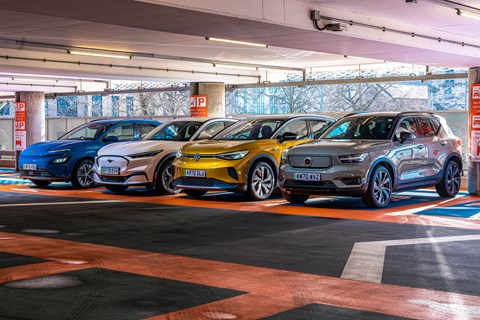
First place: Mustang Mach-E
Fun to drive and fun to be around, with decent space and far more speed than the ID.4 at the same price.
Second place: Volkswagen ID.4
Roomy, comfortable VW is in many ways the best car here, but is too sensible for its own good.
Third place: Volvo XC40
Big money, and unnecessarily rapid, it will make more sense when cheaper versions arrive.
Fourth place: Hyundai Kona
It’s small and feels dated, but it’s very easy to get on with and good value.
Read more CAR comparison tests here